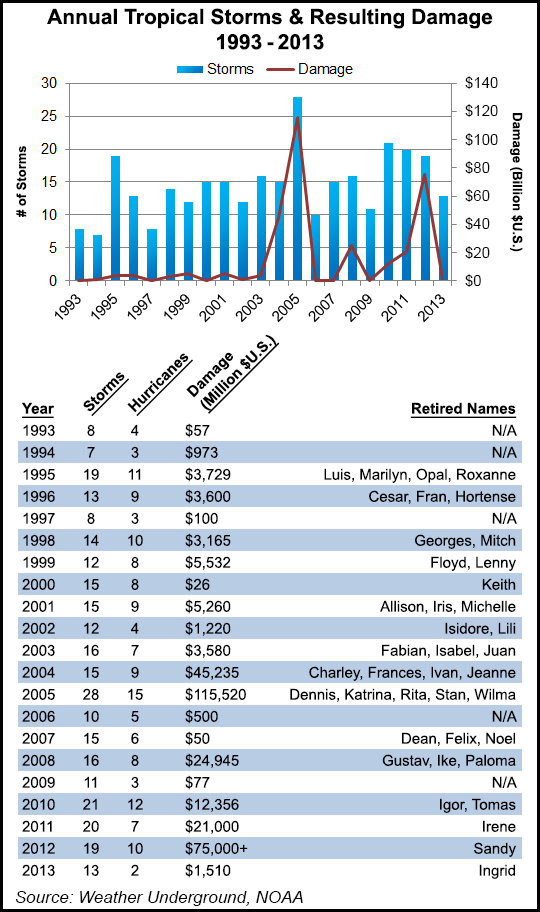Second Forecaster Expects Unusually Mild Atlantic Hurricane Season
An El Nino event in the Pacific and relatively cool waters in the Atlantic will combine to suppress the development of hurricanes in the Atlantic Basin this year, according to forecasters at Weather Services International (WSI).

The forecasters said they expect a total of nine named storms, including five hurricanes, only one of them major (Category 3 or higher), to form during the 2015 Atlantic hurricane season, which runs from June 1 to Nov. 30.
Those numbers are significantly lower than both the 1950-2014 normals of 12/7/3 and the more recent “active period” (1995-2014) normals of 15/8/3, according to Todd Crawford, WSI’s chief meteorologist.
“Both the dynamical models and our proprietary statistical models suggest a relatively quiet tropical season this year,” Crawford said. “Aggregate Atlantic basin sea surface temperatures are as cool as they’ve been since 2009, and are at the second coolest levels in 20 years. Meanwhile, in the Pacific, a new El Nino event is emerging that will likely be stronger than last year’s weaker event. The cooler ocean temperatures and subsidence/shear associated with the El Nino event will likely be a deterrent for widespread tropical cyclone development in the Atlantic.”
The WSI forecast is in agreement with one issued recently by forecasters at Colorado State University (CSU), who said they expect a total of 7 named storms, including three hurricanes, one of them major, to form in the Atlantic this year (see Daily GPI, April 10). Like WSI, the CSU team said an El Nino event in the Pacific “of at least moderate strength” this summer and fall, and “quite cool” water in the tropical and subtropical Atlantic, are expected to combine to limit tropical storm activity.
The 2014 hurricane season was a calm one, producing a total of eight named storms, including six hurricanes, two of them major and offering a relatively minor threat to North American energy interests (see Daily GPI, Nov. 26, 2014). A combination of atmospheric conditions last year acted to suppress hurricane formation, including very strong vertical wind shear, increased atmospheric stability, stronger sinking motion and drier air across the tropical Atlantic, according to the National Oceanic and Atmospheric Administration’s (NOAA) National Hurricane Center. Forecasters, including CSU and NOAA, had been prescient in their 2014 hurricane forecasts (see Daily GPI, May 22, 2014, June 3, 2014).
Increased natural gas production from U.S. onshore shale plays in recent years has lessened the potential impact of Gulf hurricanes on prices and supply (see Daily GPI, Sept. 18, 2013). Total marketed natural gas production out of the Federal Gulf of Mexico (GOM) has been on the decline since 1997, when it was 14.05 Bcf/d, according to Energy Information Administration (EIA) data. By 2014 that number had tumbled to 3.37 Bcf/d, and EIA estimates that it will continue to decline to 3.17 Bcf/d this year and 2.97 Bcf/d in 2016.
In a recent webinar, NGI‘s Patrick Rau, director of strategy and research, said there has been a large swing as to where gas is produced in the United States (see Daily GPI, April 8). The GOM in the 1990s represented around 25% of total U.S. gas production; today it’s about 5%, he said. Appalachian gas output grew from less than 6% of domestic production in 2006 to more than 20% in 2014. A replay of the 45-minute webinar is available at www.naturalgasintel.com/webinar.
© 2024 Natural Gas Intelligence. All rights reserved.
ISSN © 1532-1231 | ISSN © 2577-9877 | ISSN © 1532-1266 |
